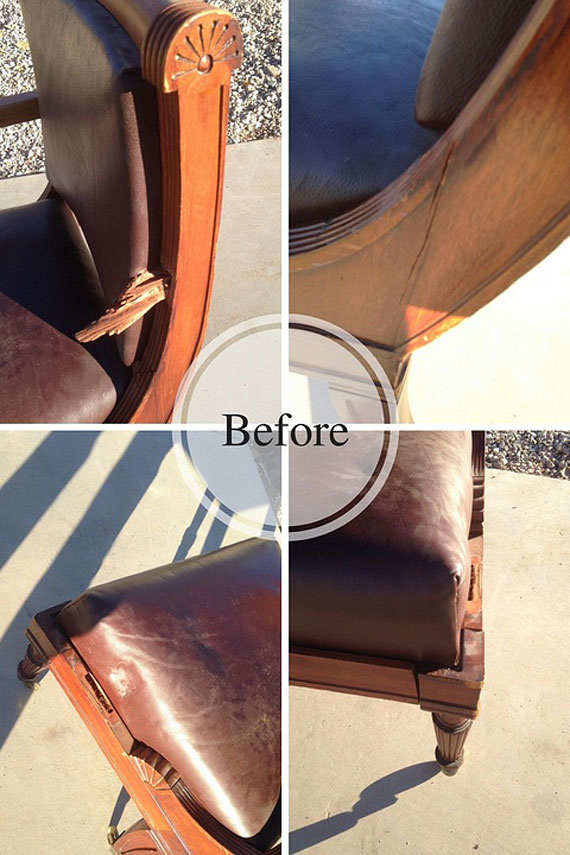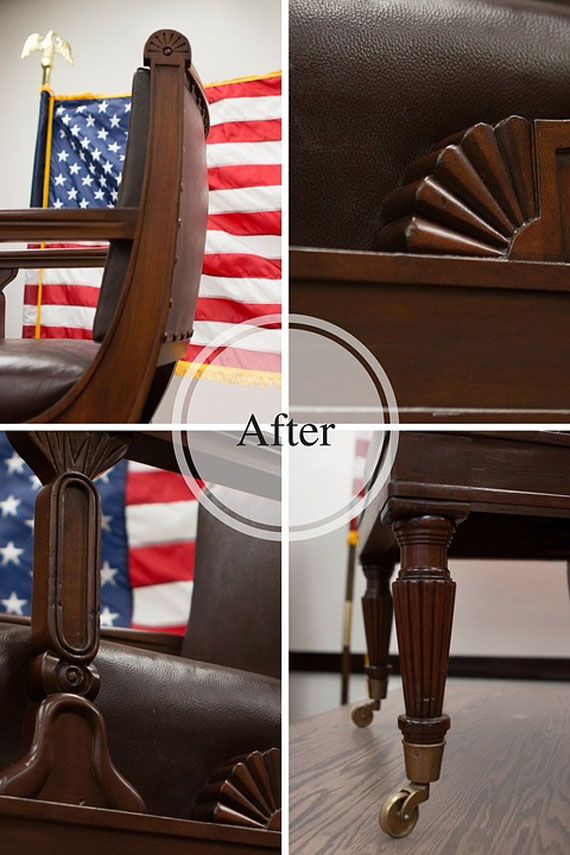A Seat of Power: Wallace F. Bennett's Senate Chair
Posted: June 13, 2016 | Author: Southern Utah University | Read Time: 8 minutes
 After a 24-year career of intense debate, close votes, and history-making compromise in Washington, DC, one can expect to emerge with more than a few proverbial scratches, bumps and bruises. So a 35 hour ride in a moving truck from Washington, DC to St. George, Utah seemed much less cutthroat than a high-level political career.
After a 24-year career of intense debate, close votes, and history-making compromise in Washington, DC, one can expect to emerge with more than a few proverbial scratches, bumps and bruises. So a 35 hour ride in a moving truck from Washington, DC to St. George, Utah seemed much less cutthroat than a high-level political career.
However, this particular journey proved to be more injury laden than a combined total of 47 years in Washington, DC. 24 years on the floor of the Senate, witnessing the passage of the civil rights act, the voting rights act, the creation of Medicare and Medicaid, Nixon’s resignation, the Vietnam War and then 23 subsequent years in the study of political lobbyist turned Southern Utah University professor Douglas Bennett, one may have thought this chair was invincible.
But, upon arrival in St. George, Bennett found his grandfather’s chair in shambles. The wooden legs were beat up, one arm was completely broken, the base had caved in, the leather was scratched, and the finish worn down. The moving truck had not been forgiving.
The Senator and his chair
This is no ordinary chair. It sat on the floor of the U.S. Senate during some of the most tumultuous political times in American history and Doug’s grandfather, Wallace F. Bennett, was at the center of it all as a United States Senator from Utah. Senator Bennett, a Republican, was elected in 1950 and served the state of Utah for four subsequent terms. While in office, he focused on water and land issues, sat on the Finance and Banking committees (eventually as the Ranking Member), the Senate Select Committee on Atomic Energy, and as the vice chair of the Senate Ethics Committee. Doug Bennett describes him as a “remarkably humble and gracious man...deeply ethical and honest with a wonderful sense of humor.”
Tom Korologos, former U.S. Ambassador to Belgium, worked as a staff member for Senator Bennett from 1962 to 1971, the last five of those years as his chief of staff. Korologos explained the Senate Chamber as being “tradition bound from top to bottom”.
The chamber is split in half by an aisle--the Democrats sit on one side and the Republicans on the other. The more senior the Senator, the closer to the front and center is his or her chair. The Majority Leader sits in the front row seat closest to the aisle, the Minority Leader sits across the aisle, (where the famous political term “working across the aisle” comes from), and each of the other chairs are assigned by seniority.

“Senator Bennett was very senior, so as I recall, he sat in the third chair over from the aisle,” Korologos said. “The chairs themselves are on wheels...and usually follow the senator as he moves closer to the front,” he explained. “Senators can buy their chair when they leave, so the chairs are rotated out frequently.”
“Senator Bennett was the Ranking Member on the Finance Committee, so whenever economic bills were up on the floor, he sat in that chair to manage the bill,” Korologos said. Whenever the Senator managed a bill, his top aide would sit next to him and be his assistant. “He would give the speech and I would take notes, and whenever the Senator was questioned on something, he would turn to me for the answer. These were pre-Google days,” Korologos reflected, “So I had to have all that data at my disposal in case someone asked a question.”
Doug spent several of his childhood summers with his grandfather in Washington, DC. The senator loved to walk in fact, as Doug recalls, he walked everyday to the Dirksen Senate Office Building--an approximately six mile journey from his DC apartment. “When I stayed with him, he would wake me up at five in the morning, and say ‘come on Doug, let’s get going, we’ve got to get to the office’, I’d make it to Dupont Circle and say ‘Grandpa, we’ve got to call a cab!’ I was fourteen years old and I was exhausted trying to keep up with him.”
Doug Bennett said those summers and many other moments working with his grandfather inspired him to get involved in politics. “It opened up a whole new world to me, I couldn’t wait to get back to Washington because it was so compelling, it was so dramatic...it’s where people were making decisions that affected the whole world, and I very much wanted to be a part of that.”
When Doug Bennett went to Washington to start his career in 1989 as counsel to the House of Representatives Committee on Energy and Commerce, most of the people who served with his grandfather were gone. One day, at a reception in the Capitol he was introduced to Senator Joe Biden. “Sen. Biden asked if I was related to Wallace Bennett, and I said that I was,” Doug remembered. Biden told Bennett “you’re always welcome in my office” and continued, “when I was first elected, before I was sworn in, my wife and daughter were killed in an automobile accident. My whole world crumbled and I was only 29 years old. But one day, I got a letter from a man I’d never met, and the letter said, ‘you don’t know me, but you have just experienced a tremendous loss and you’re about to begin a very difficult career, so if there’s ever anything I can do to help, I will."
“Well,” Doug said with a bit of emotion in his voice, “that letter was from Grandpa. Across the aisle, across the country, across the ideological lines of left and right...I think with a little bit more of that, the place [Congress] would work better.”
Back in St. George
Wallace Bennett died in 1993, and Doug said he “got the chair by wrestling it away from my little brother.” He then offered it to his uncle, Wallace’s son, Utah Senator Bob Bennett, who said “he wanted to keep his own” Senate chair, which he eventually did. So, it stayed at Doug’s home in Washington, DC until he moved to St. George in 2014. “I always like to keep it nearby, because every time I look at it, it reminds me of him (his Grandpa), and I like being reminded of him,” Doug said.
Shortly after Doug Bennett began teaching Political Science classes at SUU in the spring semester of 2014, someone told him that Clay Crozier, one of his political science students from Roosevelt, Utah had experience in building and refurbishing furniture.
Crozier said he took a cabinetry class in high school and fell in love with cabinetry and furniture design shortly after that, taking his furniture designs throughout the state to compete in fairs, always winning the top prize. Crozier did a few other furniture projects after high school, but hardly anything once he got to SUU, although his friends always liked to see the pictures of his immaculate 5-piece bedroom set and joked they wanted him to build furniture for their college apartments.
“We were in Professor Bennett’s American National Government class one day and it came up that I make wood furniture,” Crozier said. Bennett immediately asked Crozier to get in touch with him about a possible project of fixing up the chair.
Crozier said that Bennett told him this was a “side job” and not tied to his academic performance in his class.
“I told him, you do a great job on the chair and a bad job in class, you won’t get a good grade; you do a bad job on the chair and a great job in class, you’ll get a good grade--but don’t screw up the chair, “ Bennett joked.
“He had the chair for a couple of months and when he brought it back, Mary (Bennett’s wife) and I just said, ‘wow, it’s better than new!’ he did a beautiful job. We know it’s at least 66 years old, and probably older, and Clay made it look like new,” Bennett said.

“He was dazzled with it,” Crozier said “I didn’t know much about Senator Wallace Bennett before I started working on the chair, and so Professor Bennett told me a little about the history behind it and how he and his grandpa were so close.”
Crozier said knowing it was the Senator’s chair made it more of a ‘priceless item’ taking that into consideration as he was working on it. “I made sure it was done really well,” he said.
“I thought about it, and said, ‘what would Grandpa do?’, and I think Grandpa would rather have it refinished and restored by a bright young man from Utah than a random furniture shop,” Doug Bennett said.
The chair now sits in Bennett’s fourth floor office, where students visit him regularly to joke around, talk about the political news of the day and get career advice. It continues to remind Doug of the humble, funny and generous man he walked to the U.S. Capitol with during his teenage summers. After learning about Senator Wallace Bennett, it’s not surprising Doug loves working with students, and why students love him so much. He and his grandfather share many of the same personality traits.
Inspired by his favorite professor, Crozier is attending law school this fall, and eventually plans to get involved in politics. He is currently spending the summer in Washington, DC, his first time in the nation’s capital, as an intern in the U.S. Senate for Senator Lee. Although this time his work for a senator will involve policy, not furniture polish.
This article was published more than 3 years ago and might contain outdated information or broken links. As a result, its accuracy cannot be guaranteed.
Tags: Blog College of Humanities and Social Sciences Political Science Faculty

